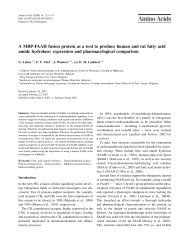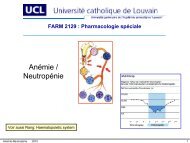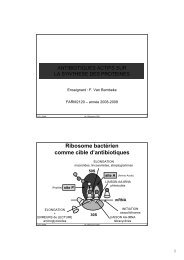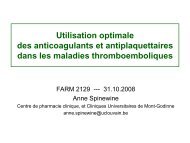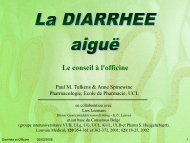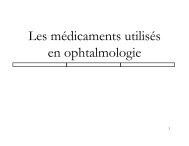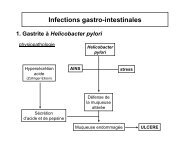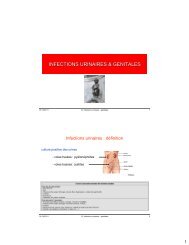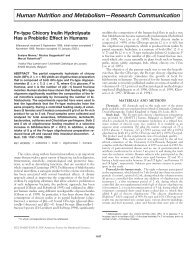Chemistry around imidazopyrazine and ibuprofen - UCL-Bruxelles ...
Chemistry around imidazopyrazine and ibuprofen - UCL-Bruxelles ...
Chemistry around imidazopyrazine and ibuprofen - UCL-Bruxelles ...
You also want an ePaper? Increase the reach of your titles
YUMPU automatically turns print PDFs into web optimized ePapers that Google loves.
Table 4<br />
pI50 values of 1,3-dithiane derivatives <strong>and</strong> references (from three independent<br />
experiments).<br />
Entry<br />
among other templates, substrate analogues, lipophilic b-lactams<br />
(azetidin-2-ones), <strong>and</strong> heterocycle-based inhibitors [43,53e55].<br />
The assay is a competitive hydrolytic experiment using the radiolabelled<br />
substrate (an<strong>and</strong>amide ¼ arachidonoylethanolamide, AEA)<br />
to measure FAAH activity. Briefly, recombinant human FAAH in<br />
buffer (pH 7.4) is added to glass tubes that contain either the drug<br />
in DMSO or DMSO alone (control). Hydrolysis is initiated by adding<br />
[ 3 H]-AEA solution <strong>and</strong> the tubes are incubated at 37 C. Tubes<br />
containing buffer only are used as controls for chemical hydrolysis<br />
(blank) <strong>and</strong> this value is systematically subtracted. Reactions are<br />
stopped by adding ice-cold MeOH/CHCl3, the radiolabelled ethanolamine<br />
is extracted <strong>and</strong> the radioactivity is measured by liquid<br />
scintillation counting (LSC). The selectivity vs. monoacylglycerol<br />
lipase (MGL) was similarly assayed, using the [ 3 H]-labelled 2oleoylglycerol<br />
(2-OG) as competitive substrate [43,53e55].<br />
The inhibition results expressed as FAAH activity (% of control) vs.<br />
drug concentration are shown in Fig. 4. From those experimental<br />
dose-response curves, the pI50 (i.e. log IC50) values were calculated<br />
(Table 3). The results clearly show that all tested <strong>ibuprofen</strong> derivatives<br />
are more active than the parent carboxylate (sodium salt) <strong>and</strong><br />
behave as selective inhibitors of FAAH vs. MGL, another hydrolytic<br />
enzyme of the endocannabinoid system. We recorded the following<br />
decreasing order of activity: 4a (entry 4, R ¼ 1,3-dithian-2-yl),<br />
11a (entry 7, R ¼ chloromethyl), 2a (entry 2, R ¼ benzotriazolyl),<br />
6a (entry 5, R ¼ nitromethyl), 7a (entry 6, R ¼ N-(hydroxy)imino), 3a<br />
(entry 3, R ¼ N-(methoxy)methylamino), <strong>and</strong> 1a (entry 1, <strong>ibuprofen</strong><br />
from commercial source). The most active compound 4a (1-(1,3dithian-2-yl)-2-(4-isobutylphenyl)-propan-1-one)<br />
was compared<br />
to related dithiane derivatives featuring fewer alkyl substituents,<br />
namely 4b (1-(1,3-dithian-2-yl)-2-phenylpropan-1-one) <strong>and</strong> 4c (1-<br />
(1,3-dithian-2-yl)-2-phenylethan-1-one). We found that the<br />
<strong>ibuprofen</strong> core significantly enhances the activity compared to the<br />
simple benzyl derivatives (Table 4, compare entry 3 with entries 4<br />
<strong>and</strong> 5). The same effect was visible when comparing <strong>ibuprofen</strong> 1a<br />
(acid, entry 1) with 2-methyl-phenylacetic acid (1b, entry 3).<br />
3. Conclusion<br />
R 2<br />
R 1<br />
O<br />
Our idea to construct an original <strong>ibuprofen</strong> prodrug based on<br />
the in situ oxidation of an imidazopyrazinone precursor (E) could<br />
R<br />
pI50 (hFAAH)<br />
Cmpd R 1<br />
R 2<br />
R<br />
1 1a Me i-Bu OH 3.55 [48]<br />
2 1b Me H OH 2.91 0.04<br />
3 4a Me i-Bu S<br />
4 4b Me H S<br />
5 4c H H S<br />
6 Ibu-am5 Me i-Bu<br />
F. De Wael et al. / European Journal of Medicinal <strong>Chemistry</strong> 45 (2010) 3564e3574 3569<br />
H<br />
N<br />
S<br />
S<br />
S<br />
N<br />
Me<br />
5.86 0.03<br />
4.00 0.03<br />
4.33 0.06<br />
5.08 0.08 [52]<br />
not be applied because the required <strong>ibuprofen</strong>-synthon (F) was<br />
synthetically inaccessible. However during our Holy Grail quest,<br />
we discovered a novel <strong>imidazopyrazine</strong> framework, presumably<br />
the imine compounds 18 (X ¼ H) (<strong>and</strong> not the corresponding<br />
oximes (X ¼ OH)). The p-hydroxyphenyl derivative 18b is<br />
endowed with antioxidant <strong>and</strong> anti-inflammatory activities <strong>and</strong><br />
appears even more active than the related imidazopyrazinone<br />
17b. Nevertheless, this result is rather difficult to exploit further<br />
due to the uncertainty about the structural assignment <strong>and</strong> the<br />
high synthetic challenge.<br />
Ibuprofen (1a) showed only a poor anti-inflammatory effect on<br />
the IL-8 secretion by the inflamed intestinal cells. This can be<br />
explained as the anti-inflammatory mechanism of NSAIDs implicates<br />
another target of the inflammation cascade i.e. the inhibition<br />
of pro-inflammatory enzymes, the cyclooxygenases (COX-1 <strong>and</strong><br />
COX-2) [56]. However, some <strong>ibuprofen</strong> derivatives with masked<br />
acid function (2a, 3a) exhibited a significant activity.<br />
Knowing that the cannabinoid system can contribute to the<br />
pharmacological effects of NSAIDs [52], we evaluated the<br />
<strong>ibuprofen</strong> derivatives against FAAH. The loss of activity of this<br />
enzyme has been shown to provide beneficial effects in models of<br />
inflammation due to the increased levels of N-acyl-ethanolamines<br />
[57]. Interestingly, we disclosed novel FAAH inhibitors among the<br />
series of <strong>ibuprofen</strong> derivatives synthesized as precursors of the<br />
synthon F. In particular, the best FAAH inhibitor 4a is more active<br />
than N-(6-(methyl)pyridin-2-yl)-<strong>ibuprofen</strong>-amide (Table 4, entry<br />
6, Ibu-am5) recently selected by Fowler et al. [52] as “lead” to<br />
explore the potential analgesic effect of compounds combining<br />
COX- <strong>and</strong> FAAH-inhibitory properties. Even if 4a is devoid of antiinflammatory<br />
action in our cellular test, its unique activity against<br />
FAAH is of interest. Indeed, the recognized therapeutic promise of<br />
FAAH inhibition for the treatment of anxiety, eating <strong>and</strong> sleep<br />
disorders, among others [50], nowadays, stimulates the research of<br />
novel inhibitors by structure-based design or high-throughput<br />
screening [58]. Our present work provides an unexpected entry in<br />
this field with the 1,3-dithian-2-yl ketone derived from <strong>ibuprofen</strong><br />
as a novel “hit”.<br />
4. Experimental protocols<br />
4.1. Materials <strong>and</strong> methods<br />
Anhydrous solvents were provided by Fluka. All reagents were<br />
obtained from AldricheFluka, Acros or ROCC <strong>and</strong> used as received.<br />
1 H(300MHz)<strong>and</strong> 13 C (75 MHz) NMR spectra were recorded<br />
on a BRUCKER AVANCE-300 spectrometer. 1 H(500MHz)<strong>and</strong> 13 C<br />
(125 MHz) NMR spectra were recorded on a BRUCKER AM-500<br />
spectrometer. The attributions were established by homonuclear<br />
<strong>and</strong> heteronuclear correlations or by selective decoupling<br />
experiments. Chemical shifts are reported as d values (in ppm)<br />
downfield from TMS for 1 H<strong>and</strong> 13 C or from CFCl3 for 19 F. The<br />
mass spectra were obtained using a Finnigan-MAT TSQ-7000<br />
instrument (FAB, EI <strong>and</strong> CI modes) or an LCQ Finnigan-MAT LCQ<br />
instrument (APCI <strong>and</strong> ESI modes). HRMS analyses were obtained<br />
at the Université Mons-Hainaut, Mass spectroscopy laboratory,<br />
Pr. Flammang or at the University College of London (UK),<br />
chemistry department, Dr. L. D. Harris laboratory. UV spectra<br />
were recorded on a UV-vis-NIR Varian-Cary spectrophotometer<br />
(l given in nm). IR spectra were determined using a Shimadzu<br />
FTIR-8400S apparatus. Thin-layer chromatography was carried<br />
out on silica gel 60 plates F254 (Merck, 0.2 mm); product visualization<br />
was effected with UV light (l ¼ 254 nm), KMnO4 or I2.<br />
For flash chromatography we used Merck silica gel 60 of<br />
230e400 mesh ASTM. Melting points were determined on an<br />
electro-thermal apparatus BUCHI Melting Point B-540.



